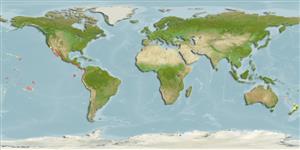Environment: milieu / climate zone / depth range / distribution range
Ecología
marino demersal; rango de profundidad 18 - 113 m (Ref. 2850). Tropical
Eastern Central Pacific: Point Conception in California, USA to Peru; rare north of Baja California, Mexico.
Tamaño / Peso / Age
Maturity: Lm ? range ? - ? cm
Max length : 15.0 cm TL macho / no sexado; (Ref. 2850); common length : 9.0 cm TL macho / no sexado; (Ref. 55763)
Short description
Claves de identificación | Morfología | Morfometría
Radios blandos dorsales (total) : 4 - 6; Espinas anales: 0; Radios blandos anales: 4; Vértebra: 18 - 19. Branchiostegal rays: 6 (Ref. 36492). First dorsal spine modified to form a lure called illicium (Ref. 36492).
Found on sand bottom (Ref. 2850). Adults feed on small crustaceans and fish (Ref. 4525). Oviparous, with planktonic larvae (Ref. 36492). Eggs are presumably contained in floating rafts (Ref. 36492).
Life cycle and mating behavior
Madurez | Reproducción | Puesta | Huevos | Fecundidad | Larva
Eschmeyer, W.N., E.S. Herald and H. Hammann, 1983. A field guide to Pacific coast fishes of North America. Boston (MA, USA): Houghton Mifflin Company. xii+336 p. (Ref. 2850)
IUCN Red List Status (Ref. 130435: Version 2024-2)
Threat to humans
Harmless
Human uses
Herramientas
Special reports
Download XML
Fuentes de Internet
Estimates based on models
Preferred temperature (Ref.
123201): 16.2 - 26, mean 20.1 °C (based on 49 cells).
Phylogenetic diversity index (Ref.
82804): PD
50 = 0.7500 [Uniqueness, from 0.5 = low to 2.0 = high].
Bayesian length-weight: a=0.02344 (0.00968 - 0.05678), b=2.94 (2.73 - 3.15), in cm total length, based on LWR estimates for this (Sub)family-body shape (Ref.
93245).
Nivel trófico (Ref.
69278): 4.0 ±0.65 se; based on food items.
Generation time: 3.7 ( na - na) years. Estimated as median ln(3)/K based on 1
growth studies.
Resiliencia (Ref.
120179): Medio, población duplicada en un tiempo mínimo de 1.4-4.4 años (K=0.3).
Fishing Vulnerability (Ref.
59153): Low to moderate vulnerability (33 of 100).
